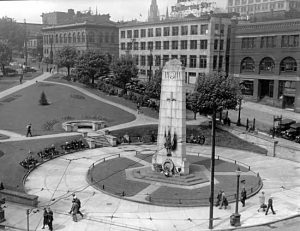- A newspaper article is published, titled “Recognition is Architects’ Aim.” The story outlined the intention of local architects to establish the status of the profession as a means of “safegaurding the public from misrepresentation.” The article states how “the granting of a certificate to an architect would mean that [they are] properly qualified to undertake work in which, it is pointed out, not only the lives of the [people] engaged in the work are sometimes at stake, but also the safety of the public during the life of the building are safeguarded.”
-
Bill 51, which concerned the regulation of architects, was passed after considerable debate, and with some amendments. The profession of architecture was now officially regulated after thirty-three years of debate.
- The provincial government appointed the first AIBC Council, which included Professor E.G. Matheson, CE, of the University of British Columbia; Percy Fox; C.E. Watkins; R.P.S. Twizell and Andrew Lamb Mercer. Their first meeting was held on June 10, 1920. Andrew Lamb Mercer was elected as the AIBC’s President.
- On July 14, 1920, an official seal for the Architectural Institute of British Columbia was chosen.
- The first AIBC Annual Dinner took place at the Hotel Vancouver, and included a toast to the King, a banjo solo, and a special menu featuring Oysters, which were “to be properly supported on fifty per cent of the shell.”
- On December 4, 1920, the first AIBC Annual Meeting was held – it took place in the Board of Trade Room on the corner of Pender and Homer Street.
- In 1924, the Victory Square Cenotaph was constructed, with 3-sides to match the triangular shape of the park itself. (Photo Credit: Frank, Leonard, VPL Historical Photographs)
- A photograph of Vancouver’s Waterfront from 1929 (Photo credit: City of Vancouver Archives):


